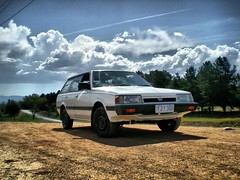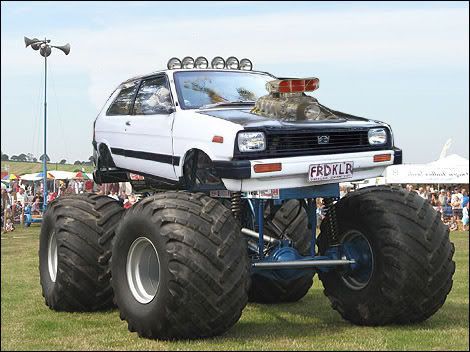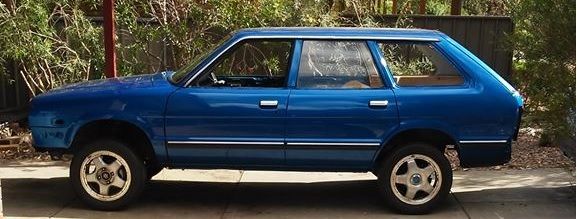
:oops:In August 1981, the second-generation Subaru Rex became front-wheel drive, with all-new bodywork and independent suspension all around. At the time, it was stated that the only parts of the rear-engined predecessor to have remained were "two connecting rods and an ashtray".[15] Power remained at 31 PS (23 kW), with a twin-barrel carburettor. Three and five-door hatchback versions were available.[5] Optional on-demand 4WD became available after October 1983, a first for the class.[5] The 4WD system was electrically engaged by depressing an embedded switch on top of the gear shift. A turbo was introduced on the 4WD Rex in December 1983. The Rex Dinos, a trim level introduced in 1982, was only available by mail order catalog.
In the European markets, this car was originally marketed as the Subaru 600 or Mini Jumbo. In September 1982 it became the Subaru 700, as it received a larger 665 cc version of the two-cylinder,[5] producing 37 PS (27 kW) (a 35 PS version using lower octane gas was also available).[16] The engine used a single-barrel carburettor. Top speed was 125 km/h (78 mph), compared to 110 km/h (68 mph) for the 31 PS (23 kW) domestic version. These cars were 9 cm longer than their domestic counterparts, due to bigger bumpers, and received 12-inch wheels (rather than the ten-inch units used in Japan).[16] Production ended in September 1986, as Subaru was getting ready to introduce the modernized third generation Rex.
The bodyshell of the second generation Rex was also lengthened and widened to become the original Subaru Justy, with a larger 1-litre engine. The Justy remained in production until 1994, outliving the next generation Rex and even the Rex label itself.
Second generation Rex
Late Rex U sedan, rear view
Rex Combi (Van version)
[edit] Third generation
Third generation
Manufacturer
Subaru
Also called
Subaru Fiori
Subaru M60/M70/M80
Subaru Sherpa
Subaru Viki
Production
1986.11–1992.03
Successor
Subaru Vivio
Layout
FF / AWD
Engine
544 cc EK23 I2
544 cc EK23 supercharged I2
547 cc EN05A I4
547 cc EN05Z supercharged I4
658 cc EN07A/E I4
658 cc EN07Z supercharged I4
665 cc EK42 I2 (export)
758 cc EN08 I4 (export)
Wheelbase
2,295 mm (90.4 in)
Length
3,195–3,295 mm (125.8–129.7 in)
The third generation (KG/KN) was presented in November 1986 with the commercial spec Rex Combi with either three or five doors. The sedan version, intended for private use, was added a month later. In addition to an SOHC two-valve engine with 30 PS (22 kW), a version with three valves per cylinder (two intake and one exhaust) and 36 PS (26 kW) was also available. There was no turbo version of the new Rex. A two-speed automatic transmission was also available, as was a part time 4WD system. "Twin Viscuous" full time 4WD with a limited slip differential for the rear axle was made available in February 1987. From this point all four-wheel drives received the more powerful three-valve engine.[17] A CVT transmission was added June 1987, called ECVT.
A supercharged version with an intercooler and electronic fuel injection was added to the options list March 1988 as a response to the success of the Alto Works and Mira TR-XX. The output of the engine increased to 55 PS (40 kW). A supercharger meant less lag than for a turbo, although specific output tended to be somewhat lower than the competition.[17] This was available for both the 3- and 5-door versions. May 1988 saw an available electrically deployed canvas top added to the 3-door.
June 1989 saw a facelift and the replacement of the EK series engine to the four-cylinder EN05 "Clover 4" with 38 PS (28 kW) available to the standard engine and 61 PS (45 kW) from the supercharged engine. This was the first Kei four-cylinder since the Mazda Carol, and was unique to the class.[17] This, the KH1/2 series Rex (KP1/2 for the commercial Rex Combis), remained available in combination with the ECVT transmission and four-wheel-drive versions, but the two-speed automatic was dropped. In July, export versions (M70 in Europe, Sherpa in Australia) received the same changes and switched from the 665 cc 37 PS (27 kW) two-cylinder to become the M80 in Europe and the Fiori in Australia.[18] This iteration was uncommonly short-lived, as in March 1990 another facelift followed, with a 660 cc version of the EN engine (EN07) and an extended, more rounded nose because of new Kei regulations taking effect. These external differences did not appear in the Australian market until August, and in Europe (Mini Jumbo, M80) by early 1991.[19] This, which was to be the last Rex, received chassis codes KH3 (FF sedan), KH4 (4WD sedan), KP3 (FF commercial), and KP4 (4WD commercial). This generation Rex was marketed as the Viki in certain Southeast Asian markets.
Second facelift, third generation Rex VX Supercharger
Rex is also a common nickname for the high-performance Subaru Impreza WRX, especially in Australia where the actual Rex was originally marketed as the Sherpa and then as the Fiori. The Fiori derivative (sold as such from summer 1989) was also equipped with pink and blue pinstriping from the factory, and a two year, 50,000 km warranty was offered when new. Equipped with a different engine, the Fiori had Subaru's 758 cc carburetted four-cylinder EN08 powerplant. This engine, producing 42 PS (31 kW) at 6,000 rpm, was also used in those European markets that received the Rex. In Europe it was rebadged M80 to reflect the engine displacement. The M80 was available as a three or a five-door, in DL and SDX versions, with the SDX receiving a standard five-speed manual. Top speed was 125 km/h for four-speeds, 130 km/h for five-speeds.[18]
The end for the Rex came in March 1992, when it was replaced by the Vivio. A total of 1,902,811 Subaru Rexes were built in its lifetime.[17] Recently the Rex has become somewhat of a cult car in Japan, being popular in front-wheel-drive drift events.
[edit] Yunque







